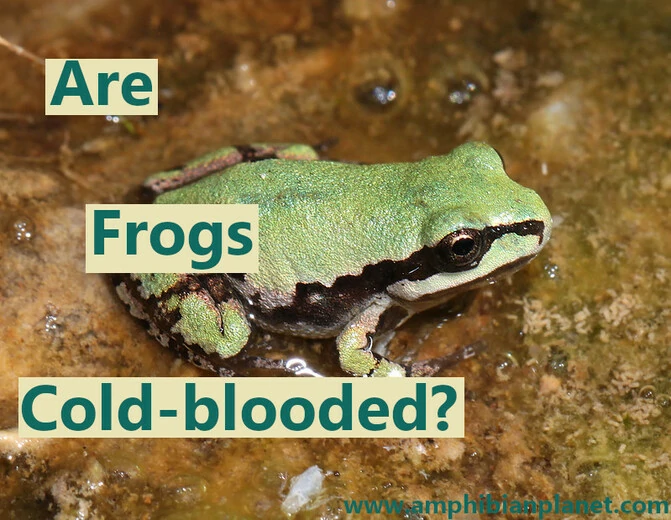In the winter, we don’t see many frogs or other amphibians around. This is because frogs cannot internally control their body temperature, so it is at the mercy of the temperatures in their environment.
Frogs are cold-blooded animals, which means they cannot regulate their body temperature. Their body temperature changes as the temperature in their surroundings changes.
When it’s warm, their bodies soak up the heat, and their body temperature rises. When it’s cooler, their body temperature falls.
That being said, it’s important to note that “ cold-blooded” is a slightly inaccurate term. The correct term is “ectothermic”.
Frogs Do Not Have “Cold Blood”
Many people have the misconception that ectothermic animals have “cold blood”. However, this is not true.
Being ectothermic or “cold-blooded” simply means that frogs cannot generate their own body heat, so their body temperatures are close to the temperature of their environment.
In other words, their environment is the main influence on their body temperature.
For example, a frog swimming in 30°C (86°F) water has a body temperature very close to 30°C. In 15°C (59°F) water, the body temperature of the same frog is around 15°C.
This is in contrast to endothermic (warm-blooded) animals, like humans whose bodies can generate their own internal heat through their metabolism.
Being ectothermic means that frogs will have a reduced metabolism at lower temperatures, and can go long periods without food. However, it also means that they are more lethargic, and become less active.
The Differences Between Endothermic (Warm-Blooded) And Ectothermic (Cold-Blooded) Animals:
Endothermic (Warm-Blooded) |
Ectothermic (Cold-Blooded) |
| Their core body temperature usually remains constant. | They do not have a specific core body temperature and it changes it according to the surrounding temperature. |
| Environmental changes have little to no effect on their metabolic rates. | Their metabolic rates change based on environmental temperature. |
| They can easily produce heat using the energy within their body. | They mainly depend on direct sunlight and heat from the surrounding environment. |
How Do Frogs Regulate Their Body Temperature?
Since frogs can not generate their own internal heat, they rely on external heat sources such as the sun to keep their bodies at optimal temperatures.
As the temperature changes at different times of day and night, they move around in their environment to regulate their body heat. This is known as “behavioral thermoregulation.”
When their body temperature is low, they move into the sun to warm up, when it is high, they move to the shade or cool water to cool down.
For instance, If a frog’s body temperature is too hot, it may move to the water to cool down.

The water is cooler than the air and not only cools the frog through conduction but also rehydrates it, which allows it to use evaporative cooling to stabilize its body temperature.
Also, since frogs have permeable skin, their body temperature tends to fall when they are exposed to moving air – due to evaporation.
Some frogs also change their body positions to adjust heat exchange via conduction and radiation.
In addition, many toads burrow or bury themselves in leaf litter to escape high temperatures. Tree frogs often hide under tree bark or inside tree hollows to cool down.
Being “Cold-Blooded” Has Advantages
Being ectothermic gives frogs many advantages that endothermic (warm-blooded) animals do not have.
1. They Require Less Food
Warm-blooded animals use a lot of energy to generate their body heat and maintain a constant temperature.
Since frogs do not generate their own body heat, they do not need much energy to regulate their body temperature. This means they require less food to survive and have to eat less often.
Many frogs in the wild can survive with only one meal a week, especially if the environmental temperatures are low.
Also, when the weather is cold, and food is scarce, frogs become inactive and don’t need to eat or will eat very little.
2. They Can Live In Harsh Environments
Since frogs do not require lots of energy to regulate their body temperature, they can live in environments with little food, which would be off-limits to most warm-blooded animals.
3. They Are Not Good Hosts for Most Bacteria and Parasites
Frogs do not have a constant body temperature. Their body temperature changes with that of their environment.
This means they are not good hosts for many bacteria and parasites that thrive in maintained warm temperatures. It is difficult for most bacteria and parasites to live in an environment where the temperature frequently changes.
Warm-blooded animals have a constantly warm body temperature, creating a good environment for bacteria and viruses to live. To counter this, most warm-blooded animals have very good immune systems.
Being Cold-Blooded Also Has Its Disadvantages
Even with many benefits, being cold-blooded also puts frogs at some disadvantages.
1. Frogs Tend to Be Sluggish in Cold Weather
Because frogs depend on the environment to regulate their body temperature, they tend to be slow and sluggish when the weather is cooler.
When the weather warms up, they need to soak up the heat from the sun and before can get more active.
2. Frogs Cannot Survive in Extreme Climates
Frogs need external heat sources, so cold climates with constantly low temperatures are too hostile for them to live in.
For this reason, most frogs are restricted to warmer regions of the world, where they can soak up heat from the environment.
In addition, most frogs cannot live in environments with constantly high temperatures.
How Do Frogs Survive Extreme Temperatures?
Exposure to extreme temperatures can be harmful to any animal, whether cold or warm-blooded. For cold-blooded animals, this risk of injury or death is even greater because their body temperature is dependent on the temperature of the environment they are in.
For this reason, frogs have adapted to cope with both cold and extreme heat.
To deal with cold winter temperatures, frogs migrate to overwintering sites that insulate and protect them from the cold.
Terrestrial frogs may overwinter in underground burrows, deep cracks in rocks/logs, or deep in leaf litter.
Aquatic frogs, on the other hand, may overwinter at the bottom of ponds where the temperatures are warmer.

When the temperature drops, frogs enter a state of dormancy where their metabolism drops by up to 95 percent.
This allows them to survive without food all winter long, so they do not have to go out to forage for food in the bitter cold.
In the summer when the temperatures rise, terrestrial frogs will keep cool by spending most of their under rocks, logs, and over natural cover near ponds and other water bodies. They mainly come out at night to feed when the temperatures are cooler.
Aquatic frogs simply move to cooler areas of the water. This helps them avoid the heat and keep their body at optimal temperatures.
Sometimes Frogs “Hibernate” in the Summer to Escape the Heat
Sometimes, frogs enter a state of dormancy when the environmental conditions are very hot and dry. This is known as estivation (also spelled as aestivation).
During estivation, the breathing rate, heart rate, and general metabolic rate all decrease, just as they do in hibernation. Think of it as some sort of “summer hibernation”.
If the summer weather gets too hot, frogs will find a cool moist place and estivate as they wait for the temperatures to drop.
Can Frogs Freeze to Death?
If the temperatures drop and remain cold for extended periods, most frogs can freeze to death. However, some frogs can survive being completely frozen! During this, the frog will stop breathing, its heart will even stop beating and it will appear dead.
Five frog species in North America are known to survive being frozen; namely:
- Wood frog (Lithobates sylvaticus)
- Eastern gray tree frog (Hyla versicolor)
- Cope’s gray tree frog (Hyla chrysoscelis)
- Western chorus frog (Pseudacris triseriata)
- Spring peeper (Pseudacris crucifer)
Of these, the most well-studied is the wood frog.
After ice starts to form on a wood frog’s skin, the frog’s liver begins converting sugars, stored as glycogen, into glucose creating a sort of anti-freeze.
This sugar is released from the liver and carried through the bloodstream to every tissue where it helps keep cells from completely dehydrating and shrinking.
Inside each cell, the glucose keeps the cells plump and strong and prevents ice crystals from forming which would kill them.
As the wood frog is freezing, its heart continues pumping the protective glucose around its body, but the frog’s heart slows and eventually stops and all other organs stop functioning. The frog also stops breathing.
In this state, up to 70% of the water in a frog’s body can be frozen.
Wood frogs can survive all winter like this, undergoing several cycles of freezing and thawing as the temperature changes.
When the weather gets warmer, the frog thaws out, and its body replaces some damaged cells – but the frog is unharmed.
Frequently Asked Questions:
Do Frogs Like Hot or Cold?
Different frog species have different needs and preferences, but most frogs generally prefer temperatures between 20°C (68°F) and 30°C (86°F).
Some species can do well at even lower temperatures, and some such as wood frogs and spring peepers can survive temperatures below freezing by turning into frozen “frogsicles”.
What Temperature Do Frogs Like?
Most frogs will thrive in temperatures ranging between 20°C (68°F) and 30°C (86°F). At temperatures of below 10°C (50°F), most frogs will become sluggish and get less active – and at temperatures above 30°C (86°F), most frogs will move to the shade or cool water to cool down.
What Temperature Is Too Cold for a Frog?
Experiments by scientists Maurel and LaGriffe studied the effect on frogs of temperatures ranging from -4°C (24.8°F) to 41°C (105.8°F) and concluded that frogs cannot survive a temperature of -5°C (23°F) but may survive a temperature of 0°C (32°F) to -3°C (26.6°F).
What Temperature Is Too Hot for a Frog?
Scientists believe that the high-temperature limit of an animal is the point at which the proteins of the body begin to coagulate. The experiments of scientists Maurel and LaGriffe concluded that 39°C (102.2°F) to 40°C (104°F) is the maximum temperature at which frogs can survive – and only for short periods.
In addition, another experiment found that a frog’s striped and unstriped muscle undergoes a contraction at about 39°C (102.2°F) due to the coagulation by the heat of the protein in the muscle fiber. The muscle undergoes another contraction at about 50°C (122°F) due to changes in the connective tissue elements in the muscle.
The experiment concluded that exposure of the frog’s muscle to a temperature of 40°C (104°F) for a very short period is fatal.
Furthermore, another experiment found that frogs got heat paralysis in their nervous tissue at a temperature of about 34°C (93.2°F).
Conclusion
Frogs are ectothermic animals. However, this does not mean they have “cold blood”. It simply means that they can not generate their internal body heat, so they rely on external heat sources to regulate their body temperature.
As the temperature changes at different times of day and night, they move around in their environment to regulate their body heat.
When the winter comes, they migrate to overwintering sites to protect themselves from the cold.


